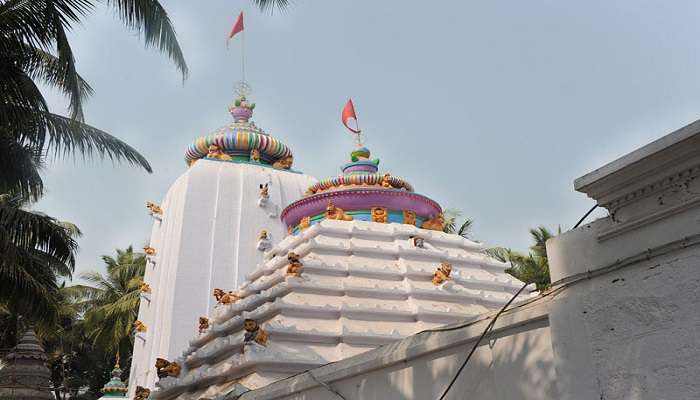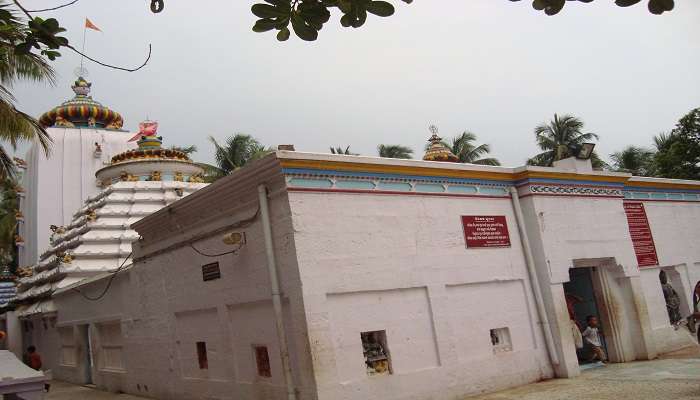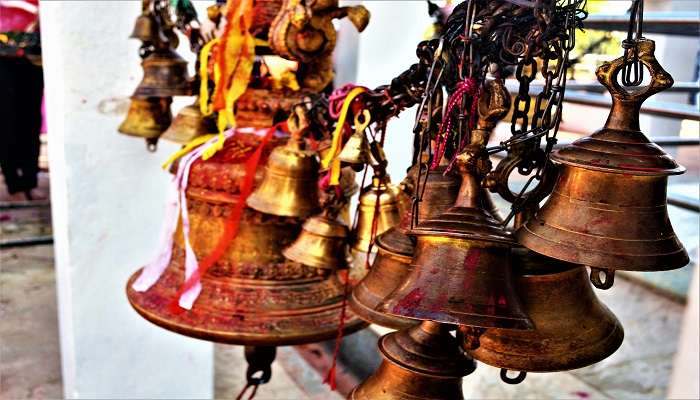Visit Biraja Temple And Explore The Divine Temple Of Odisha In 2025

Going deep into India’s cultural fabric, the Biraja Temple is one of the few living witnesses to the ancient era. Also known as Biraja Kshetra, the temple was built in honour of the goddess Biraja. This temple dates back millennia and is still a fascinating example of early devotional construction and design. Many myths and legends are related to the temple’s history or at least link it to their narratives. Initially built in the 13th century, the temple was repeatedly reconstructed and expanded over several years. The temple is visited throughout the year, and there is a continuous stream of rituals and festivals, giving the place a lively feel. Among them, Navratri, Durga Puja, and Chaitra Parba are highly popular annual fairs that attract devotees from various corners of the country.
History Of Biraja Temple

The significance of this temple is written about in Biraja Kshetra Mahatmya, a section of Skanda Purana. It is believed that Goddess Parvati performed penance at this site to pray for a reunion with Lord Shiva. There is also a belief that Lord Brahma carried out a few yagnas near the banks of the Baitarani River.
Maa Parvati emerged from the yagna fire, and Lord Brahma named her Maa Biraja. Biraja Kshetra is large and triangular. Lord Shiva is on three sides, watching over the Kshetra. Lord Shiva is seated on three of the triangle’s corners, with Maa Biraja in the centre. According to another belief, when Lord Shiva carried the burnt body of Sati, her navel fell at this site, making it a sacred place for the devotees. The temple is one of its kind among the 51 Shakti Peethas in India and a mecca for devotees of Shaktism.
Also Read: Places Near Puri
The Significance Of Biraja Temple, Jaipur

One of India’s oldest shrines or temples and a significant pilgrimage site is the Biraja Temple in Jajpur or Biraja Khera in Odisha. The main religious symbol of the Biraja Temple is the statue of Goddess Biraja, also known as Girija, which symbolises Goddess Durga. Its central figure is the goddess Durga in her form known as Mahishasuramardini or the destroyer of the buffalo demon Mahishasura. Although some later examples have two arms, one hand is depicted grasping the buffalo demon’s chest with a spear, while the other grabs the tail.
During Durga Puja, Kali Puja or Makar Sankranti, Bengalis fully decorate their homes with colourful idols and beautifully arranged flowers and lights to celebrate these occasions as per traditions followed here.
Top Reasons To Visit Biraja Temple Jaipur

Below are the top reasons why you should visit Biraja Temple to experience the cultural and natural beauty of the place:
1. Historical legacy: According to records, the temple has existed at least since the fourth century AD and is recorded in several kavya (poems) and other historical sources. A temple visit could showcase notable Odisha people from the Middle Ages while also introducing tourists to the rich Odia culture.
2. Architectural look: Biraja Temple’s stunning architectural arrangement will grab your attention. It reflects the Kalinga style of architecture and is characterised by intricately carved designs, towering buildings, and stunning entrance domes. The temple has a walled enclosure and several mandapas for different deities, the main shrine being the Garbhagriha.
3. Religious purity: At the Biraja Temple, experience pure spirituality while offering prayers to the Lord. The temple’s atmosphere and divine presence are meant to inspire those seeking a deeper spiritual connection.
4. Natural beauty: Besides its historical significance as a tourist attraction, the Biraja Temple offers a lovely escape from the hectic life of a city tour. A lush, green forest region connects to its beautiful architecture, making it an ideal tourist spot.
5. Getaway destination: Feel the calm thousands of Goddess Biraja devotees experience every year when they come to the temple to pay their respects to Biraja Mata. The trip to the temple is a beneficial and balancing experience, regardless of whether it is intended for a solo or group of individuals.
Related Post: Haunted Places In Odisha
Places To Visit Nearby Biraja Temple

You can explore a wide range of locations near Jajpur’s Biraja Temple. Below is
a list of a handful of them.
1. Brahma Kund: It is close to the Biraja Devi Temple Complex—just a short distance away. It is the location of the temple tank where Lord Brahma carried out the Yagna, from whence the Devi arose. There previously was a forest named Champak van that wrapped around Brahma Kund. A busy town now surrounds it!
2. Varaha Temple: The Varahanatha Temple, also known as the Varaha Temple, is the next stop. It is situated across from the Dashaswamedh Ghat on the left bank of the Baitarani River. The temple was constructed in the Kalinga architectural style between the fifteenth and sixteenth centuries AD.
3. Odisha State Maritime Museum: From the coast of Odisha to Java, Sumatra, and other ancient places, the marine museum provides a fantastic glimpse at such expeditions. It boasts a fantastic 4D theatre as well as a tiny aquarium. Overall, it is well worth the money and the few hours you invest. Just across the street, you can stroll along the shores of the Mahanadi River.
4. Lalitgiri: This excavation site is close to Chandikoli, along with the Buddhist sites of Udayagiri and Ratnagiri. Four monasteries are within walking distance of the main entrance, offering monks a place to meditate. A museum greets you at the entry, and a stupa sits on a little hill.
Culinary Delights At Biraja Temple Of Jaipur

Visiting the city of Odisha’s cuisine will undoubtedly not let you down. These foods are a must-try when in Jajpur’s Biraja Temple.
1. Chhena Poda: Chhena Poda, meaning “burnt cheese,” is a traditional Odia delicious piece made of fresh chhena (cottage cheese), sugar, and cardamom. It is baked until a brown crust forms.
2. Rasagola: Soft cheese balls dipped in a thin sugar syrup are known as rasagola, a popular treat. The rasagola from Odisha differs from the Bengali variety in terms of taste and texture.
3. Bhata Pakhala: A classic Odia meal, Pakhala Bhata is made from fermented rice soaked in water. It is usually eaten with fish, fried vegetables, and Badi Chura, crushed fried lentil dumplings.
4. Dalma: Lentils and various vegetables are cooked with spices and tempered with ghee to make the healthy dish Dalma. It has a pleasant flavour and is popular in Odia households.
Related Post: Picnic Spots In Odisha
Entry Fee And Timings

The opening and closing timings of Biraja Temple Jajpur are:
Morning: 6:00 AM – 1:00 PM
Evening: 3:00 PM – 10:00 PM
Entry Fees (If any): A ticket is not required to enter the temple. Pilgrims can pray, receive the deity’s darshan, and eat prasadam. Though few offerings are not required, certain Hindu temples may welcome donations to help maintain and maintain. Therefore, please feel free to bring one.
The Best Time To Visit Biraja Temple Jaipur

The ideal time to visit Jajpur’s Biraja Temple is winter, from October to March. The excellent weather throughout the winter months makes it easy for visitors to enjoy the district’s attractions.
Related Post: Tourist Places In Odisha
How To Reach Biraja Temple Jaipur

The Biraja Temple in Jajpur may be reached in three different ways: by road, Jajpur Bus Stand is only 2 km from the temple; by train, Jajpur Railway Station is 32 km away; and by air, Biju Patnaik International Airport is 103 km away.
Practical Tips To Keep In Mind
Always act politely and culturally appropriately when visiting the Biraja Temple Jajpur in Odisha.
Considering that this is a house of worship, dress modestly and cover your entire body.
Remove your shoes and store them at the appropriate stands when approaching the temple area.
It is advised to wear modest clothes in the Biraja Temple in Jajpur. Dressing appropriately for both genders is advised even though there is not a set dress code:
Men:
Sleeved top or kurta
Full-length pants (trousers, dhoti, or pyjamas)
Women:
Kurta with dupatta, salwar kameez, and saree
You May Also Like To Read: Shopping In Orissa
Going to the Biraja Temple Jajpur in Odisha and praying is a spiritually enriching experience. It involves balancing spiritual calm, lively culture, and historical relevance. Consider useful advice and other details to get the most out of your trip to this revered temple in Odisha. Make the most of your spiritual adventure by planning your trip to Odisha immediately!
For our editorial codes of conduct and copyright disclaimer, please click here.
Cover Image Credit: John Wormell for Wikimedia Commons
Frequently Asked Questions About Biraja Temple
Does the Biraja Temple have a place to make offerings or prasad?
Yes, vendors outside the shrine sell prasad and offerings. As part of their worship, devotees can present the god with fruits, flowers, and other offerings.
Is lodging offered close to Biraja Temple?
Of course, there are plenty of lodging options in Jajpur, including hotels, lodges, and guesthouses. Booking in advance is advised, particularly during the busiest times of the year for pilgrimages.
Does Biraja Temple offer guided tours?
Yes, you can arrange a guided tour at the temple itself or through one of the nearby tour operators.
Does the temple have any dress code requirements?
It is intended that visitors will dress modestly, with their knees and shoulders covered. It is best to dress traditionally.
Is there a fee to enter Biraja Temple?
Entering the temple does not require any fee. It is open to pilgrims who wish to visit and pray at the temple.
People Also Read:
Bhavishya Badri Temple Manu Temple Hoysaleswara Temple

Unveil the hidden treasures of the globe and turn every travel dream into reality. As a Content Writer, I am passionate enough to craft stories from ancient wonders to modern marvels. My words paint the picture-perfect itinerary for unforgettable experiences. Let my words be your trusted guide to immerse in the diverse culture and discover the beauty of the unknown.











